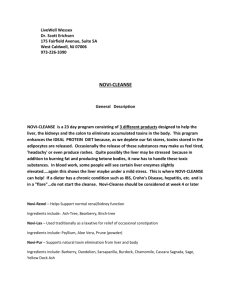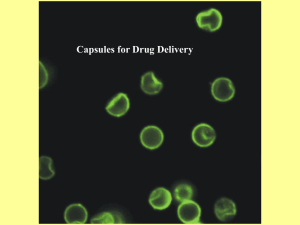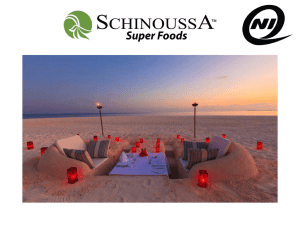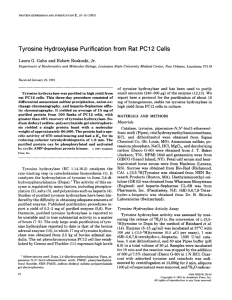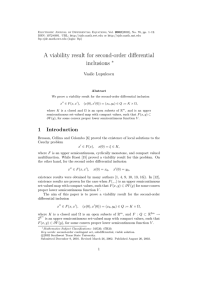Preparation „FUNAIKANG" FNK
advertisement
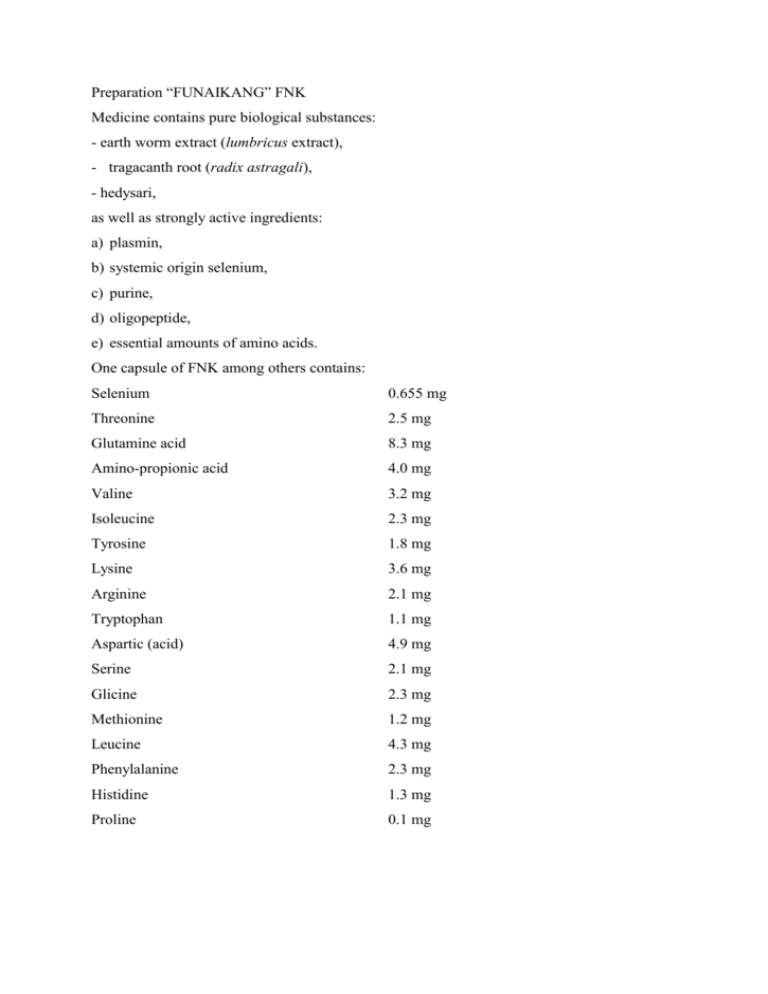
Preparation “FUNAIKANG” FNK Medicine contains pure biological substances: - earth worm extract (lumbricus extract), - tragacanth root (radix astragali), - hedysari, as well as strongly active ingredients: a) plasmin, b) systemic origin selenium, c) purine, d) oligopeptide, e) essential amounts of amino acids. One capsule of FNK among others contains: Selenium 0.655 mg Threonine 2.5 mg Glutamine acid 8.3 mg Amino-propionic acid 4.0 mg Valine 3.2 mg Isoleucine 2.3 mg Tyrosine 1.8 mg Lysine 3.6 mg Arginine 2.1 mg Tryptophan 1.1 mg Aspartic (acid) 4.9 mg Serine 2.1 mg Glicine 2.3 mg Methionine 1.2 mg Leucine 4.3 mg Phenylalanine 2.3 mg Histidine 1.3 mg Proline 0.1 mg Composition and the way of preparing FNK capsules FORMULARY Funaikang Jionang (Funaikang capsules) Composition: fresh Lumbricus 4200 g, Astragali seu Hedysari root 250 mg. Preparing: Fresh Lumbricus is treated with ultrasound for 15 minutes, then is frozen for 24 hours at temperature -10 oC. Defrost at temperature 15 oC and smash in colloid mill, then add 13440 ml water and stir the bulk thoroughly. Keep at low temperature for 3 hours, next filter on vacuum filter. To the filtrate add 3800 ml of water and keep at the temperature 44 oC for 3 hours. Then filter the bulk again, two parts of filtrate are combined and kept in refrigerator for 24 hours. Astragali seu Hedysari root is boiled for 2 hours in water, next filtered. Obtained filtrate is kept in refrigerator for 4 hours; then combined with filtrate obtained earlier and centrifuge (6000 rpm) for 30 minutes. The supernatant liquid is frozen and powdered under vacuum, then divided for 1000 parts - capsules. Properties: Single capsule contains preparation in the form of light brown or red-brown loose powder, ready soluble in water, of slight fishy smell. Verification: (1) In order to prepare useful solution into 0.05 g of medicine add 1 ml of 0.5 mol/l NaOH. In order to prepare control solution into 1 ml of 0.5 mol/l NaOH add 6-hydroxypurine of concentration 0.5 mol/l. Then take 5 l of sample and 2 l of control solution. The method of paper chromatography is used (Chines Pharmacopoeia, 1990, part A, appendix page 56), samples are separately pippeted on chromatographic paper. Using coating agent - solution of ethyl alcohol-acetic acid-water (85:5:10) spread samples. Wave paper until dry. Next paper is examined under UV light (254 nm). On the chromatogram examined sample, in the position corresponding to control sample, is visible as spot of similar colour. (2) (a) Preparation of buffer solution 3-hydroxy-metylo-amino-metan 0.05 mol/l, pH 7.5. In order to prepare buffered solution pH 7.5 to 3.03 g of 3-hydroxy-metylo-amino-metan add 125 ml of water, 190 ml of HCl (0.1 mol/l) and some amount of distilled water. Then add water up to 500 ml. (b) Preparation of solution to be tested. To 0.15 g of tested medicine add 10 ml of buffer solution of 3-hydroxy-metylo-amino-metan, pH 7.5. Next centrifuge with speed 3000 rpm. The supernatant liquid is examined (this solution should be prepared directly before using). (c) Preparation of blood cloth. Venous blood taken from rabbit auricular vein is quickly introduced into plastic tube, diameter 2 mm. The tube, until used, is kept in refrigerator. (d) Method of investigation. 6 ml of tested solution and 6 ml of buffer solution 3-hydroxy-metylo-amino-metan, pH 7.5, are transferred into separate tubes. Into each of tubes add 20 mm of prepared blood cloth from the plastic tube. Test tubes are then closed with lid and transferred into incubator, keep at temperature 37 oC. Every two hours tubes should be shaken, test result is obtained after 6 hours time. Heamolysis of blood cloth should take place in each tube, in the tube containing control sample heamolysis is not observed. Control: The hygiene control. The hygiene standards should be in accordance with one published by Ministerstwo in 1986 (Standards of medicine hygiene). Moreover the medicine has to be produced according to all principles and recommendation for capsule production (Chines Pharmacopoeia, 1990, part A, appendix page 16) Composition determination: Nitrogen contents. Weigh exactly part of the capsule contents (equivalent of 1.0 - 2.0 mg of nitrogen). Then the nitrogen content is determined (Chines Pharmacopoeia, 1990, part A, appendix page 45, method number two). One ml of HCl (0.005 mol/l) solution is equivalent of 0.1401 mg of nitrogen. The nitrogen contents calculated from the dry sample of tested medicine should not be lower than 8.5 %. Protease activity (1). Preparation of control solution. Weigh exactly 5 mg of tyrosine, dried at the temperature 105 oC to the solid form; then in order to prepare 100 ml add the buffer 3-hydroxy-metylo-amino-metan, pH 7.5. (2) Preparation of solution to be tested. Weigh exactly 0.1 g of tested medicine and transfer it into 10 ml volumetric flask filled up to the mark with buffer 3-hydroxy-metylo-amino-metan solution, pH 7.5. Then the sample is centrifuged for 15 minutes, 3000 rpm. Take 1 ml of the supernatant liquid and transfer it into another 10 ml volumetric flask filled up to the mark with buffer 3-hydroxy-metylo-amino-metan solution, pH 7.5. (3) Test method. Add exactly 1 ml of tested medicine into each of 3 test tubes. Heat them for 10 minutes in water-bath at temperature 40 oC. Add exactly 5 ml of tyrosine solution, warmed up in water-bath at temperature 40 o into each tube (this solution is prepared by adding 50 ml of buffer 3-hydroxy-metylo-amino-metan solution, pH 7.5 to 0.6 g of tyrosine and dissolving at water bath at temperature 60 oC; after cooling down the buffered solution is added to make up 100 ml). Shake the test tubes and to start up the chemical reaction immediately transfer into water-bath at temperature 40 0.5 oC, for exactly 10 minutes. Then add exactly 5 ml of 5 % trichloroacetic acid. The reaction is interrupted. Shake the test tubes and filter samples. Discard the first part of filtrate, rest is used for determination. Take exactly 1 ml of tested medicine solution and transfer into water-bath, temperature 40 oC, for 10 minutes. Again add exactly 5 ml of 5 % trichloroacetic acid and immediately 5 ml of tyrosine solution. Shake the test tube and filter the sample. Discard the first part of filtrate, rest is used as a blank. Using spectrophotometry (wave length 280 nm) conduct the determination and calculate the mean value (A) of tested solution absorbance (Chines Pharmacopoeia, 1990, part A, appendix page 51). As a blank the absorbance of buffer 3-hydroxy-metylo-amino-metan solution, pH 7.5 is used: protease activity unit in each g = A x Ws x 11 x n/As x 181.19 x 10 x W where Ws is tyrosine contents (ug) in each ml of control solution, W is the mass of tested medicine (g), n dilution number of tested medicine solution. Under this condition as a activity unit is taken solution free from precipitate, formed by hydrolysed tyrosine within one minute time (peptide and amino acids, ect.), wave lengths 280 nm and enzyme contents equal to 1 umol of tyrosine. A value of tested solution should be within the range from 0.15 to 0.6, if it is different the concentration should be adjusted and the test repeated. Activity and indication: Activation of blood, removal of haemostasis, helps fever, neutralisation of poisons, improving immunity, removing of pathogens. This medicine increases immunity, stimulates appetite, reduces side effects of radio- and chemotherapy, helps convalescence after surgery. Dosage and administration: 3 times daily, before meal; adults 3 x 3 capsules; children 3 x 2 capsules as a one part of therapy (360 capsules), the therapy could be continued for 3 to 6 months. Medicine should be taken with warm drink. Packages: 80 mg capsules, described with letters FNK. Content of capsule is lose powder, capsule is orange colour. Storage: Store in dry, cool place, closed, keep away from light.


